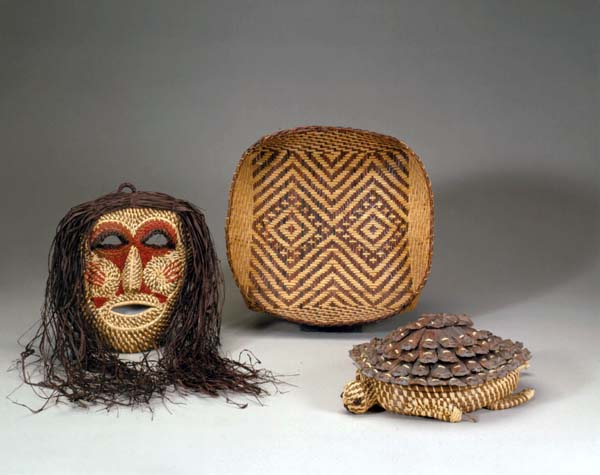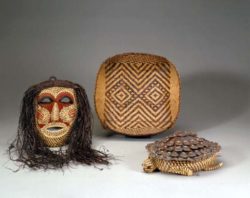Native American Basketry
A hallmark of southeastern Indian societies, cane basketry traditions persist in fewer than ten contemporary tribal communities in the southeastern United States, including three in Louisiana.

Courtesy of New Orleans Museum of Art.
Rose Langley, Ronald Langley, and Edna Lorena Langley of the Coushatta Indian Tribe, made these contemporary pieces, respectively: "Mask," of pine needles and raffia; "Fanner Basket," of split needle cane and commercial dye; and "Large Turtle Basket with Lid," with pine needles and pine cones.
Across the pre-Columbian American Southeast, indigenous women wove cultural identity and social experience into baskets and matting of native cane (Arundinaria gigantea). A hallmark of southeastern Indian societies, cane basketry traditions persist in fewer than ten contemporary tribal communities in the southeastern United States, including three in Louisiana. Largely created for community use, cane basketry was commodified when southeastern Indians entered into an exchange-based colonial economy with their European neighbors.
Cane basketry is one of the oldest sustained artistic traditions practiced by American Indians. In Louisiana, native Chitimacha, Caddo, Opelousas, and Atakapas weavers crafted utilitarian and ritual items from bamboo-like river cane that was gathered, divided into splints of diverse widths, dried, often dyed, and twilled or plaited into baskets and matting. Baskets could be single or double-walled and were created in a variety of forms and sizes. Some baskets were undecorated or minimally decorated and were used for daily activities like gathering and storing plant foods, winnowing grains, and for storing clothing and other personal items. Matting could be utilized to demark space within houses or used as bedding. Other baskets and mats were highly embellished with zoomorphic or geometrical designs and motifs created by interweaving splints dyed with tints derived from plant and animal sources and were used for ritual activities like burials.
Colonial Europeans were quick to recognize the usefulness of native technology, particularly crafts like basketry that combined utility with beauty and exotic appeal. Highly skilled native weavers developed local markets among colonial settlers in Louisiana, where paniers sauvages (Indian baskets) were common in household inventories, especially the almost watertight double woven trunks that were crucial for storage in the days when houses had no closets. A few rare examples of colonial-era native basketry survive today as treasured family heirlooms.
In the eighteenth century, a number of groups from east of the Mississippi River crossed into Louisiana to avoid English and later American encroachment into tribal territories and to gain economic advantage by interacting closely with French Creole Louisianians. Among the immigrant tribes were members of the Tunica, Biloxi, Ofogoula, Choctaw, Alabama, Koasati, Apalachee, and other small nations. Each group brought its own unique cane basketry traditions to Louisiana, as well as a coiled basketry tradition in which longleaf pine straw, sweet grass, or sedge grass is coiled and sewn to create a basket or tray. Later, white oak was sometimes adapted for use when cane was not available.
The acquisition of Louisiana by the United States had profound consequences for Indian nations. Indian trade and alliances, so crucial to European colonials, lost importance with the economic shift to large-scale agriculture, and the influx of land-hungry Americans created new problems for tribal communities. Reduced in number and restricted in range, tribal communities consolidated in marginal areas away from Anglo-European settlements, or were forced to abandon ancestral homelands altogether. With increasing isolation, fewer Indian people brought baskets to market; but for some, basketry remained a significant source of income and an important expression of cultural identity.
Throughout the eighteenth and nineteenth centuries, American Indian weavers, especially Chitimacha, Choctaw, and Koasati, sustained markets for their basketry by trading directly with rural neighbors or transporting their wares to urban centers like New Orleans. Even in the twentieth century, when artistic traditions were threatened by changing tribal economies, poverty, and diminishing sources for cane and pine straw, weavers continued to recognize both the cultural and economic value of cane basketry and worked diligently to keep their traditions viable. Today, four American Indian nations reside in Louisiana—the Sovereign Nation of the Chitimacha, the Tunica-Biloxi Tribe of Louisiana, the Sovereign Nation of the Coushatta Tribe of Louisiana, and the Jena Band of Choctaw Indians. Weavers from all four nations carry forth basketry traditions that stretch back into prehistory.
The only Louisiana Indians to continuously inhabit a portion of their ancient homelands, the Chitimacha once claimed a vast area stretching from east of the Mississippi River through the Atchafalaya Basin. From the early eighteenth century, Chitimacha basketry was highly prized for its quality and complex designs and Chitimacha basketry can be found in museums throughout the world. The majority of these baskets date from the late-nineteenth to early- twentieth century, known as “the Golden Age of Native American basketry.” The intricate design motifs on Chitimacha basketry reflect iconography associated with the Southeastern Ceremonial Complex (Southern Cult) of the Mississippian Tradition (ca. A.D. 1200-1600). Unusual among southeastern basketry traditions, Chitimacha designs bear specific names. Designs like nish-tu wa-ki (alligator entrails), cous-pi si-ou (muscadine rind), tcik ka-ni (blackbird’s eyes), and tcish mish (worm track) reflect the natural world of early weavers “who first captured these impressions in cane.” Chitimacha basketry is so conservative that a basket produced at the turn of the century is indistinguishable from a similar example made today. This remarkable consistency may be attributed in part to the careful curation of heirloom pattern baskets passed down within the families of weavers.
The Tunica nation was one of the first immigrant tribes to inhabit Louisiana, settling on the west bank of the Mississippi River by ca. 1706, then later consolidating in Avoyelles Parish where they remain today. Like other strong nations, the Tunica absorbed smaller groups reduced by war and disease, including groups of Ofogoula and Biloxi. In the latter half of the twentieth century, the cane basketry tradition in this community was supplanted by basketry made of coiled pine straw.
The Alabama and Coushatta (Koasati) originated in Alabama and Georgia, but had largely migrated to Louisiana by the late eighteenth century. The Alabama eventually crossed into Texas and settled with some of the Coushatta. The majority of Coushatta eventually settled in and around Elton, Louisiana, where their tribal headquarters is located today. Coushatta weavers made both cane basketry and coiled basketry, and continue to work with both materials today; however, many weavers specialize in one material or the other. Unique to the Coushatta are the pine straw effigy baskets crafted into a wide range of animal shapes.
Choctaw people brought their basketry traditions with them when they began to cross the Mississippi River in large numbers after Spain acquired Louisiana in 1763. Groups of Choctaw settled throughout Louisiana, including a village that was established before 1807 near Catahoula Lake. After Indian Removal in the 1830s, Choctaw from Mississippi joined or settled near this small village in what is now La Salle Parish. Jena Choctaw weavers continued to make and sell baskets until the second half of the twentieth century, but the loss of elders and women seeking work outside of home diminished the tradition. In the 1980s, however, cane basketry was brought back into the community and remains today a significant cultural tradition for the tribe.
Diverse in form, function, and material, Louisiana Indian basketry traditions remain strong signifiers of tribal culture and history and represent links in an unbroken chain that connects the ancient past to the present.
